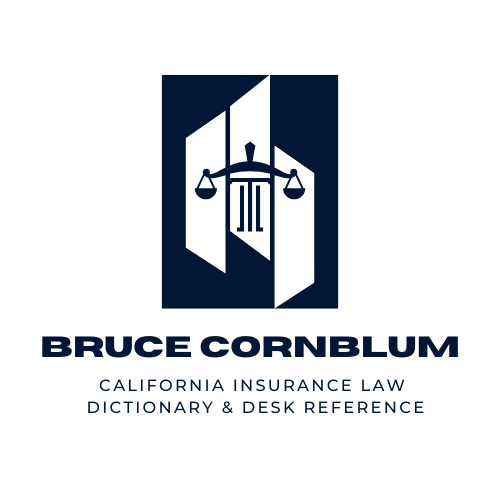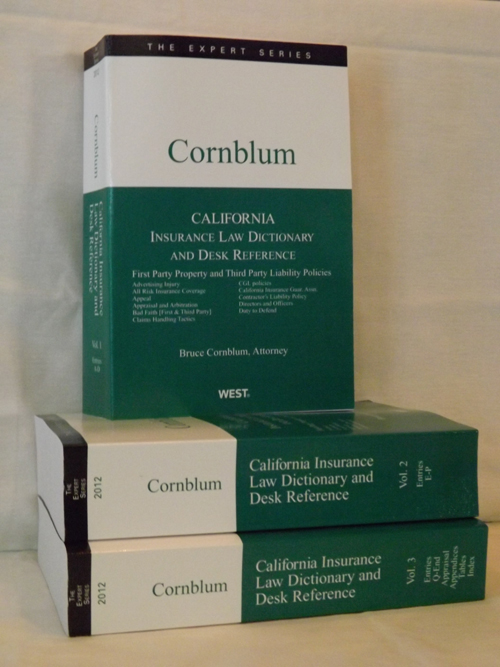EXCLUSION: INTELLECTUAL PROPERTY
CGL policies containing coverage B for ‘advertising injury’ will contain an exclusion for suits involving intellectual property. The exclusion states:
“We won’t cover injury or damage or medical expenses that result from any actual or alleged infringement or violation of any of the following rights or laws:
• copyright [§ C117 COPYRIGHT COVERAGE UNDER CGL POLICY]
• patent [§ P18 PATENT INFRINGEMENT]
• trade dress [§ T37 TRADE DRESS]
• trade name [§ T39 TRADE NAME]
• trade secret [§ T40 TRADE SECRET]
• trademark [T41 TRADEMARK INFRINGEMENT]
• other intellectual property rights or laws.”
“Nor will we cover any other injury or damage that’s alleged in any claim or suit which also alleges any such infringement or violation. BUT WE WON’T APPLY THIS EXCLUSION to bodily injury or property damage that results from your products or your completed work. See § C53 COMPLETED OPERATIONS; § P95 PRODUCT HAZARD. Nor will we apply this exclusion to advertising injury that results from the unauthorized use of any
• copyrighted advertising material
• trademarked slogans; or
• trademarked title;
of others in your advertising.” (emphasis added)
[see SBCC Inc. v. St. Paul Fire (2010) 186 Cal.App.4th 383, 391, 112 Cal.Rptr.3d 40]
Discussion: Under the intellectual property exclusion, no coverage is afforded if the alleged injury results from:
1. misappropriation of trade secrets,
2. or violation of other intellectual property rights or laws.
3. The intellectual property exclusion also excludes coverage for ‘… any other injury or damage that’s alleged in any claim or suit which also alleges any such infringement or violation’. [SBCC Inc. v. St. Paul Fire (2010) 186 Cal.App.4th 383, 396-397, 112 Cal.Rptr.3d 40 (third party suit alleged causes of action for wrongful misappropriation of confidential information from plaintiff plus claiming misappropriation of trade secrets; exclusion applied)]
◆ OBSERVATION: Where the underlying suit contains patent infringement claims (excluded), intellectual property exclusion eliminates coverage for claims ‘alleged in the suit that also alleges any such infringement’. [SBCC Inc. v. St. Paul Fire (2010) 186 Cal.App.4th 383, 397, 112 Cal.Rptr.3d 40] It is to be noted that defamation in unfair competition claims are not clearly within the reach of the intellectual property exclusion. Also disparaging statements are not ‘directly or indirectly related’ to intellectual property infringement within the meaning of the intellectual property exclusion. [SBCC Inc. v. St. Paul Fire (2010) 186 Cal.App.4th 383, 397, 112 Cal.Rptr.3d 40 (citing federal court opinions)] See § A35 ADVERTISING INJURY [§ A35:14.1].
Misappropriation of “method patent” involving “advertising ideas”
Certain patent infringements can constitute advertising injury. This is described as a “method patent”, i.e. a patent of a “process or invention which reasonably can be an advertising idea”. Such patented methods are also referred to as marketing methods. A marketing method is a patent in the form of an electronic system creating customized products by rendering visual images in response to specific request by the potential customer. In Hyundai Motor America v. National Union the insured Hyundai infringed upon a method patent injuring a third party holder of the patent. The Court of Appeal held that this process was a “misappropriation of an advertising idea”. [Hyundai Motor America v. National Union (2010, CA, 9th Cir.) 600 F.3d 1092, 1103 (policy did not contain an intellectual property exclusion as discussed in SBCC Inc. v. St. Paul Fire (2010) 186 Cal.App.4th 383, 397, 112 Cal.Rptr.3d 40] See analysis § A35 ADVERTISING INJURY [§ A35:18 Exclusions].
◆ COMMENT [Patent infringements are usually excluded]: Except for limited circumstances, patent infringement allegations are not covered under a commercial general liability (CGL) policy. See § P18 PATENT INFRINGEMENT [§ P18:1 Liability policy]. A claim of patent infringement does not occur in the course of advertising activities within the meaning of a CGL policy even though the insured advertises the infringing product, if the claim of infringement is based on the sale or importations of the product rather than its advertisement. [Bank of the West v. Superior Court (1992) 2 Cal.4th 1254, 10 Cal.Rptr.2d 538] More specifically, the advertising activities must cause the injury, not merely expose it to the public. [Hyundai Motor America v. National Union (2010, CA, 9th Cir.) 600 F.3d 1092, 1103] Where, however, the patent relates to a ‘process or invention which could reasonably be considered an advertising idea’, which idea is a ‘form of advertising itself’, absent an intellectual property exclusion to the contrary, coverage exists under a CGL policy extending coverage for ADVERTISING IDEAS. [Hyundai Motor America v. National Union (2010, CA, 9th Cir.) 600 F.3d 1092, 1103] See § A35 ADVERTISING INJURY [§ A35:13 Patent infringement not covered].
Exception: An exception rule that patent infringement is not covered as a “misappropriation of ideas” is where the third party plaintiff alleges the “elements of the advertisement itself, in its context, form, logo, or pictures, rather than in a product being advertised itself”. [Hyundai Motor America v. National Union (2010, CA 9th Cir.) 600 F.3d 1092, 1101] This is referred to as a “violation of a method patent” involving advertising ideas. [Hyundai Motor America v. National Union (2010, CA 9th Cir.) 600 F.3d 1092, 1100-1101] See § P18 PATENT INFRINGEMENT [§ P18:2].
* BOLD references are to Mr. Cornblum’s 2-Volume legal treatise CALIFORNIA INSURANCE LAW DICTIONARY AND DESK REFERENCE. The new 3-Volume 2011 Edition to be published by West Publishing mid-2011. You may purchase the treatise by clicking here.

